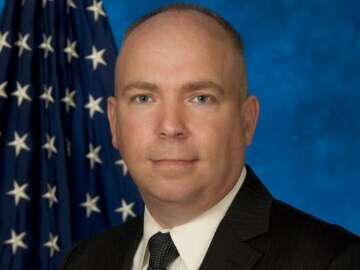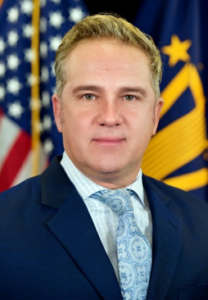
SBA shuffles its CIO chair once again
The DoD deputy chief information security officer and the Justice Department’s ATF CISO also announced they were leaving federal service.
To listen to the Federal Newscast on your phone or mobile device, subscribe in PodcastOne or Apple Podcasts. The best listening experience on desktop can be found using Chrome, Firefox or Safari.
After four years of stability in the chief information officer’s role, the Small Business Administration is back to the CIO shuffle.
Since Maria Roat left in 2020 to become the federal deputy CIO, SBA is on its third technology leader as Stephen Kucharski assumed the acting title in late June or early July.
Kucharski replaces Luis Campudoni, who had been acting since January when he took over for Keith Bluestein.

Campudoni returns to his former deputy CIO role.
Bluestein took a leave of absence in January and now, according to his post on fundraising site GiveSendGo, now SBA is trying to remove him from federal service.
Bluestein said he filed a claim with the Merit Systems Protection Board (MSPB) on July 8.
“Once the administrative law judge (ALJ) reviews the preliminaries, they will establish a calendar or schedule for events to occur such as discovery, motions, hearing, etc. The process is very event driven and the MSPB has a very good record of sticking to their 120-day process timeline. What does that mean? Once the ALJ sets the schedule we will have a very compressed time to interview witnesses and such before our hearing. This is a huge step for us as we were unable to compel anyone from my agency to offer us statements after I was notified of what I was charged with,” Bluestein wrote. “Despite having more than ample people that could offer a counter to the agency narrative, the indications we have were that the agency discouraged any government employees from engaging in any conversations with me or my legal representatives. Therefore, the deciding official (person who made the decision to remove me) only considered one side of the argument as legitimate.”
Bluestein said he believes the appeal to MSPB will expose “this false narrative” about him.
It’s unclear what the “false narrative” Bluestein is referring too as the reason for his initial leave of absence and now seemingly removal from federal service.
An SBA spokesman said back in January and again on Aug. 4 that the agency doesn’t comment on personnel matters.
As for the new acting CIO, Kucharski has been with SBA for 23 years, including the last 14 as a senior executive. He comes to the acting CIO role after leading the systems delivery of SBA’s Office of Capital Access programs for the Recovery Act, the Jobs Act, the CARES Act, the Economic Aid Act and the American Rescue Plan Act, including the Paycheck Protection Program that processed 14 years’ worth of SBA loans in 14 days.
Multiple sources say while Kucharski is a capable technologist, putting him in charge of the CIO’s shop is another questionable move by SBA leadership.
Current and former government sources familiar with SBA say Kucharski’s move does a few things that are causing concern.
One former federal executive said moving the system lead from the Office of Capital Access to the CIO’s role is a major power shift.
“The new leadership of Capital Access wants to make their mark by making SBA a venture capital company. This would have SBA becoming a direct small business loan maker rather than guarantor for all small business loans. Right now, disaster loans are currently direct loans. The whole operation is built on a 1990s legacy system that was a real problem with PPP, and it is hard to see how it could be modernized for the new role,” said the source, who requested anonymity.
Another source said Kucharski is not a “hands on” technology leader and not as “forward thinking” as he needs to be given SBA’s progress over the last five or six years.
“SBA has been asking around for anyone interested in the [CIO] job. A number of folks have said no, because the mess Maria and Guy [Cavallo, the OPM CIO] cleaned up has now built back up and it’s getting messier and messier,” the second source, who requested anonymity, said. “It’s a shame, too. It goes to show all the good work folks do and put in can get erased really fast due to poor follow on leadership.”
SBA says Kucharski laid out four main objectives as acting CIO:
- Fully leveraging the technology investments and process improvements that enabled SBA’s successful implementations of the CARES Act, Economic Aid Act and the American Rescue Plan.
- Embracing SBA’s mission IT successes by harmonizing shared service models for cloud services, performance data reporting and help desks.
- Continue the cybersecurity and network modernization across SBA’s nationwide sites, datacenter and colocation facilities, and headquarters.
- Executing the administrator’s “My SBA Initiative.” This strategic priority will improve the way SBA delivers services to small businesses but also improve how SBA program offices collaborate and work together.
Kucharski is saying all the right things in his goals and plans. But sources say SBA has taken steps backward since Roat and her team in the CIO’s office have moved on to new jobs around government.
SBA was a model of IT modernization for four years but slipped backwards over the last year or so. Let’s hope Kucharski gets the agency back on track since Roat famously said she burned the bridges back to on-premise data centers.
USAID, NARA name new CIOs
Three other changes in the CIO ranks you may have missed too.
My colleague Justin Doubleday broke the news that Jason Gray, the Education Department CIO, was heading to become the CIO at the U.S. Agency for International Development. That opens up a spot at Education.
Gray is taking over for Jay Mahanand, who quietly left that role in January to take over as CIO at the United Nations World Food Program.
That means Education is now looking for a new CIO just as USAID filled their whole.
Now, the transition at the National Archives and Records Administration was a lot more typical.

Sheena Burrell, who has been the deputy NARA CIO for February 2020, assumed the top slot earlier this month, according to her LinkedIn profile.
She takes over for Swarnali Haldar, who retired in July after more than eight years in the role.
Burrell has been with NARA since 2019, coming to the agency as an associate CIO for business and investment management. She has worked in the federal government since 2001 when she started at the Social Security Administration as a policy analyst.
As the CIO, Burrell inherits a $126.8 million IT budget, according to the IT Dashboard. Of that $126.8 million, more than 40% ($41 million) is spent on development, modernization and enhancement efforts. NARA also is managing the cost and schedule of its projects well, according to the dashboard.
Burrell also has been leading an effort to move NARA toward a zero trust architecture, with a big focus on protecting their data.
DoD, ATF lose cyber executives
There were a few other technology executives on the move you may have missed.
Jay Ribeiro, the chief information security officer at the Justice Department’s Bureau of Alcohol, Tobacco, Firearms and Explosives, announced on July 29 he was leaving after four years in the role.

Ribeiro said his last day would be Aug. 26.
“Packing it all up. #bittersweet moment. After 4 great years — time to accept another challenge. Time to get uncomfortable. Thank you #ATF for all the love and support,” he wrote on LinkedIn.
Ribeiro joined ATF in 2019 after serving as the CISO for the Federal Election Commission for almost two years. He also worked at the State Department, the Air Force, the Army and for the Defense Department in various cyber roles.
Ribeiro didn’t say what he would be doing next or who would be acting CISO in the interim.
Over in the DoD CIO’s office, deputy CISO Mark Hakun is retiring after 34 years of federal services. His last day was at the end of July.
DoD CIO John Sherman said on LinkedIn that Hakun was a top cyber professional who impacted the intelligence community and DoD.
“I can’t wait to see what he’s going to accomplish in the next phase of his career. I’ve been lucky to work Mark since 2018, when he was the deputy NSA CIO, Sherman wrote. “Fair winds and following seas, Mark, and thanks for all you’ve done here in DoD CIO!”
Hakun served for more than two years as NSA deputy CIO and before that spent more than a year on detail as the director of the National Background Investigation Services where he modernized the IT services to conduct investigations and move them back to DoD from the Office of Personnel Management.
Additionally, Hakun served in executive roles at the Space and Naval Warfare Systems Command and served in the Navy for almost a decade.
Finally, former DoD chief data officer David Spirk landed a new job. He is now a senior counselor for Palantir Technologies.
Spirk left DoD in May after just over two years as its CDO. He also worked at the U.S. Special Operations Command for two years in a similar role.
He wrote on LinkedIn that he will be “focused on the U.S. government and international business. I’ve dedicated my career to ensuring the U.S. government has a data strategy that protects against our adversaries and leverages the best technologies to ensure our competitive edge. Palantir not only provides this technology, but even more important is their mission-focus on ensuring we extend this lead and that data-driven decision making is at the forefront of our national security strategy.”
Dr. Clark Cully is acting CDO for DoD.
Copyright © 2025 Federal News Network. All rights reserved. This website is not intended for users located within the European Economic Area.
Jason Miller is executive editor of Federal News Network and directs news coverage on the people, policy and programs of the federal government.
Follow @jmillerWFED
Related Stories




